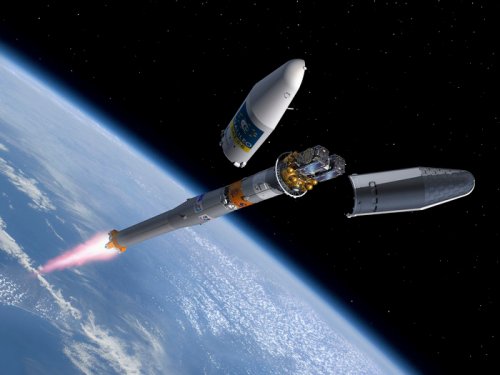
(Artist’s view of the Soyuz rocket carrying the two satellites into orbit – Photo Credit: ESA/J. Huart)
Final testing of the European Space Agency’s twin Galileo navigation satellites has been completed at Europe’s Spaceport in French Guiana, signalling that the agency are on track to launch the duo into medium-Earth orbit on August 21st.
Fuelling the two satellites, which will allow them to fine-tune their orbits and maintain their altitude over their 12-year lifetimes, took place between the 7th and 8th August. Engineers donned protective SCAPE (Self Contained Atmospheric Protective Ensemble) suits to fill the satellites with hydrazine propellant.
The duo were then installed together onto the dispenser that secures them to the Soyuz rocket’s Fregat upper stage and the satellites were encased within their protective launch fairing.
 (The two satellites meet for the first time, attached to the dispenser that will carry them into medium-Earth orbit – Photo Credit: ESA/Arianespace)
(The two satellites meet for the first time, attached to the dispenser that will carry them into medium-Earth orbit – Photo Credit: ESA/Arianespace)
ESA will now proceed with final launch operations. The combined upper composite – also known as the ‘space head’ – will be attached to the other three stages of the powerful Soyuz ST-B rocket later in the week.
The Galileo satellites are scheduled to liftoff on Thursday 21st August at 12:31 p.m GMT (2:31 p.m CEST and 8:31 a.m EDT)
Just 9 minutes and 23 seconds later, the Fregat upper stage, which carrying the payload, will separate from the Soyuz third stage and conduct a pair of engine burns.
Three hours, 47 minutes and 57 seconds after launch, the satellites will be deployed into free-flight orbit by a pyrotechnic separation system once their final 23, 500 km altitude is achieved.
 (Another image of the two new satellites – Photo Credit: ESA/Arianespace)
(Another image of the two new satellites – Photo Credit: ESA/Arianespace)
On board each satellite, an automatic sequence will be triggered, switching the spacecraft on, booting up the onboard software, deploying a pair of solar arrays and orienting the spacecraft toward the Sun.
Once in orbit, the Galileo satellites will create Europe’s own global navigation satellite system, providing a highly accurate, guaranteed global positioning services.
These two new satellites will join four other Galileo satellites, launched in October 2011 and October 2012, which are already in orbit. A steady stream of Galileo launches are planned over the next few years.
You can watch the launch live via a webcast on the ESA’s website.